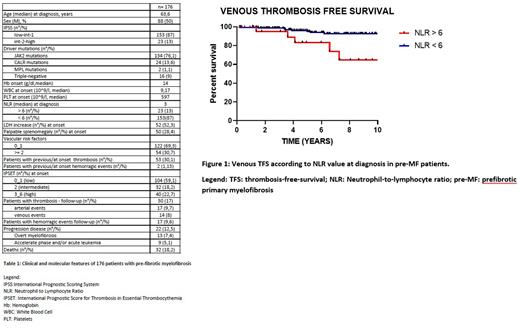Abstract
Background Thrombosis is a common complication in patients (pts) with myeloproliferative disease: it represents the product of a dysfunctional interaction between erythrocytes, platelets, leukocytes and endothelium. A pro-inflammatory microenvironment appears to be associated with an increased thrombotic risk. Neutrophil-to-lymphocyte ratio (NLR) reflects the balance between systemic inflammation and immunity and is emerging as a prognostic biomarker in several diseases, including hematological ones. Recently Carobbio et al. [BCJ, 2022] described NLR as a predictor of venous thrombosis in Polycythemia Vera. No score was specifically developed to assess thrombotic risk in myelofibrosis (MF), and even less is known in the setting of prefibrotic primary myelofibrosis (pre-MF).
Aims In a multicenter cohort of pre-MF pts, we retrospectively investigated the relationship between NLR values at diagnosis and the risk of: 1) thrombosis 2) disease progression into overt-MF, accelerated (AP) or blast phase (BP); 3) overall survival (OS).
Methods We collected clinical, histopathological and hematological data of 176 pts with a diagnosis of pre-MF, revised according to 2016 World Health Organization criteria, followed at 4 Hematological Centers between 2002 and 2022.
NLR values were calculated using data obtained from the complete blood count at diagnosis, as the ratio between absolute neutrophilic count (ANC) and absolute lymphocyte (ALP) count.
Pts were dichotomized using the best threshold identified by ROC analysis. Thrombotic complications included arterial (ischemic stroke, myocardial infarction, peripheral arterial disease) and venous (deep vein thrombosis, pulmonary embolism, cerebral and splanchnic vein thrombosis) events. Thrombosis-free survival (TFS) and OS were determined from pre-PMF diagnosis to the first thrombotic event and to death or last contact, respectively. TFS/OS were estimated by Kaplan-Meier analysis; the log-rank test was used to compare TFS/OS differences between risk stratified groups.
Results Overall, 176 pts were included in this study. Median age was 63.6 (range 25-80) years; 88 (50%) were male. Majority of pts were JAK2V617F mutated (76,1%). Median NLR value at diagnosis was 3 (range 0,64-41,5). By ROC analysis, 6 was identified as the best cut-off value to dichotomize pts based on NLR; 23 pts (13%) presented NLR >6 at diagnosis.
A major thrombotic event occurred before or at diagnosis in 53 pts (30,1%): 29 arterial and 25 venous (one patient had both a venous and arterial event). During the follow-up (FU), 30 pts (17%) developed a thrombosis, for a total of 38 thrombotic events (20 venous and 18 arterial events, accounting for an incidence rate of 1,67 and 1,50 per 100 pts-year, respectively).
In statistical analysis, factors significantly associated to thrombosis during the FU were previous thrombosis (p=0.05) and JAK2 V617F mutation (p=0.03). Total leucocyte and platelets count, as well as age, sex and IPSET thrombosis score did not correlate with thrombotic events. Pts with ANC > 9 x10^9/L or ALP count < 1,5x10^9/L at diagnosis showed a trend towards a greater incidence of thrombosis in FU (p=0.06 and p=0.07, respectively). Pts with NLR value > 6 at diagnosis had a significantly higher incidence of venous thrombotic events (p=0.03) and a shorter venous TFS (p=0.004, Figure 1) compared to patients with NLR <6. The NLR value was not predictive of arterial thrombotic risk.
After a median FU of 6.14 years (range 0,5-27,96) years, 32 pts (18,2%) died; 22 pts (12,5%) had disease progression: of them, 13 (7,4%) experienced overt MF and 9 (5,1%) evolved into an AP or BP. Pts with NLR value > 6 at diagnosis had a significant shorter OS compared to the group with NLR <6 (median OS 4,93 vs 6,22 months respectively, p=0.02).
Conclusions This multicenter study investigated for the first time whether the NLR value at diagnosis could be a predictive marker of thrombotic risk and poor outcome in pre-PMF setting. Previous thrombosis and JAK2V617F mutation are confirmed to be risk factors for thrombotic events also in pre-MF setting. Notably, NLR > 6 at diagnosis emerged as a simple marker to identify pts at higher risk of thrombosis and poor outcome in the pre-PMF setting: pts with a NLR value > 6 have a significantly higher venous thrombotic risk and a shorter venous TFS. Furthermore, NLR group > 6 appears to have a shorter OS. These data are promising but require to be confirmed on a larger scale.
Disclosures
Palandri:Amgen: Consultancy, Honoraria; Sierra Oncology: Consultancy, Honoraria; Celgene: Consultancy, Honoraria; Kartos/Telios: Consultancy, Honoraria; CTI: Consultancy, Honoraria; AOP: Consultancy, Honoraria; Sobi: Consultancy, Honoraria; Novartis: Consultancy, Honoraria.
Author notes
Asterisk with author names denotes non-ASH members.


This feature is available to Subscribers Only
Sign In or Create an Account Close Modal